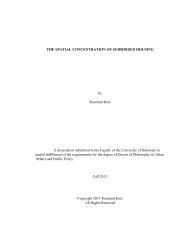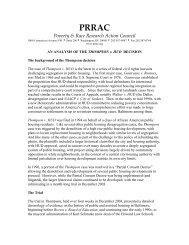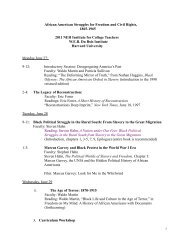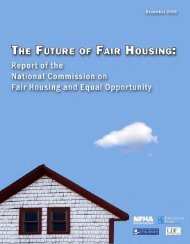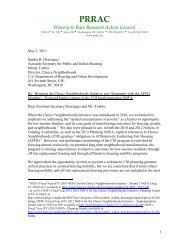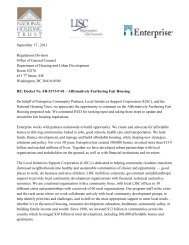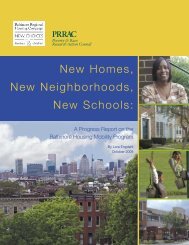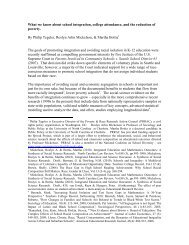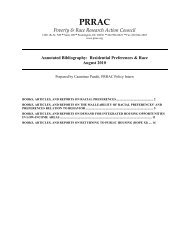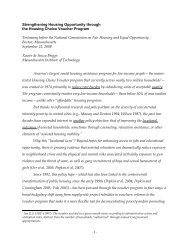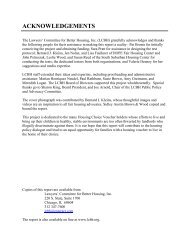Annotated Bibliography of Housing Mobility Research 2006-2010
Annotated Bibliography of Housing Mobility Research 2006-2010
Annotated Bibliography of Housing Mobility Research 2006-2010
Create successful ePaper yourself
Turn your PDF publications into a flip-book with our unique Google optimized e-Paper software.
Abstract:<br />
Educational failure is one <strong>of</strong> the costliest and most visible problems associated with ghetto<br />
poverty. This article explores whether housing assistance that helps lowincome families move to<br />
better neighborhoods can also improve access to good schools. <strong>Research</strong> on the Gautreaux<br />
housing desegregation program indicated significant, longterm educational benefits, yet results<br />
from the Moving to Opportunity (MTO) experiment showed no measurable impacts on school<br />
outcomes for the experimental group. Using interviews and ethnographic fieldwork, finds that<br />
most MTO families did not relocate to communities with substantially better schools, and those<br />
who did <strong>of</strong>ten moved again after a few years. Where parents had meaningful school choices, these<br />
were typically driven by poor information obtained from insular social networks or by cultural<br />
logic centered on avoiding ghettotype school insecurity and disorder, not garnering academic<br />
opportunity. Those factors may not shift if poor families with less educated parents are served by a<br />
relocationonly strategy.<br />
Briggs, Xavier de Souza, Susan J. Popkin & John Goering, Moving to Opportunity: The Story <strong>of</strong><br />
An American Experiment to Fight Ghetto Poverty, New York: Oxford University Press (<strong>2010</strong>)<br />
Summary: Examines the MTO experiment by focusing on three questions: 1) Where does lowincome<br />
housing assistance belong in the effort to reform economic opportunity policies appropriate to the<br />
twentyfirst century; 2) how can we improve the quality <strong>of</strong> life <strong>of</strong> poor people – in particular, <strong>of</strong><br />
poor families who endure the severe challenges <strong>of</strong> raising children in violent ghetto neighborhoods<br />
– even as we also look for ways to help them escape poverty; and 3) as the nation responds to the<br />
economic crisis that was triggered by a credit crisis in real estate, how should we rebuild the<br />
“housing ladder” without shortchanging affordable rental housing for the sake <strong>of</strong> promoting<br />
homeownership Includes chapters focusing on ghetto poverty pre and postKatrina, MTO<br />
design and implementation, housing quality, finding good schools, and finding work.<br />
Buron, Larry, & Satyendra Patrabansh, “Are Census Variables Highly Correlated With<br />
<strong>Housing</strong> Choice Voucher Holders’ Perception <strong>of</strong> the Quality <strong>of</strong> Their Neighborhoods”<br />
Cityscape 10(1): 15784 (2008)<br />
Abstract:<br />
Presents the results <strong>of</strong> a study examining voucher holders’ ratings <strong>of</strong> their neighborhoods on the<br />
U.S. Department <strong>of</strong> <strong>Housing</strong> and Urban Development’s <strong>Housing</strong> Choice Voucher Program<br />
Customer Satisfaction Survey. Specifically, the study examines whether these ratings were<br />
internally consistent and whether they were highly correlated with any census neighborhood<br />
variables <strong>of</strong>ten used as measures <strong>of</strong> neighborhood quality. Finds that voucher holders’<br />
neighborhood ratings were consistent with their answers to more specific survey questions about<br />
the attributes <strong>of</strong> their neighborhoods but only weakly correlated with censusbased measures <strong>of</strong><br />
neighborhood quality. Internal consistency was demonstrated by the strong correlation between<br />
neighborhood ratings and voucher holders’ perceptions <strong>of</strong> crime problems and physical disorder in<br />
their neighborhoods. Concludes that although a very systematic correlation exists between the<br />
neighborhood rating and census measures <strong>of</strong> the neighborhood, the correlation was not very strong<br />
for any <strong>of</strong> the census variables tested. The variable with the strongest correlation (percentage <strong>of</strong><br />
femaleheaded households with children) explained less than 5 % <strong>of</strong> the variation in the<br />
neighborhood rating. Thus, the census tract poverty rate does almost as well to measure<br />
neighborhood quality as more complex measures drawing upon multiple census variables.<br />
Chapple, Karen, “Overcoming Mismatch: Beyond Dispersal, <strong>Mobility</strong>, and Development<br />
Strategies,” Journal <strong>of</strong> the American Planning Association 72(3): 322336 (<strong>2006</strong>)<br />
Abstract:<br />
Since the 1960s, John Kain's theory <strong>of</strong> spatial mismatch has influenced policy responses to the<br />
poor employment prospects <strong>of</strong> lowincome and minority residents <strong>of</strong> inner cities by aiming to<br />
connect them with suburban jobs. This literature review examines this policy legacy using what<br />
4



